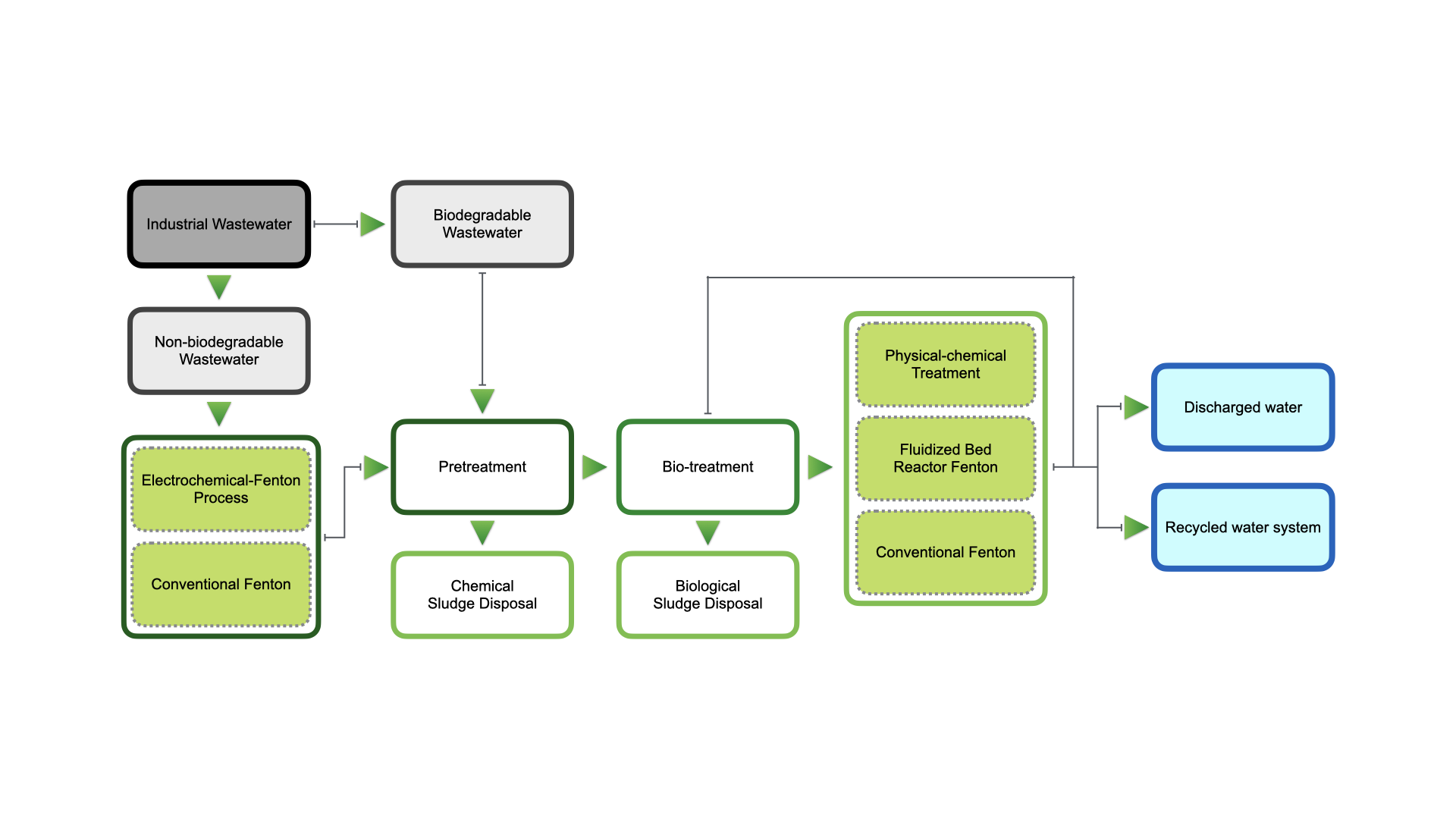Wastewater Treatment
Wastewater Treatment Overview
Advanced Oxidation Technologies for Wastewater Treatment
I. Technical Brief
There is a lot of industrial wastewater treatment plant, that requires additional high-level wastewater processing units to achieve the effluent standards of the local government. The development of advanced wastewater treatment technologies includes ozone oxidation method, activated carbon adsorption method, membrane separation method, wet oxidation method, Fenton oxidation method, etc. Among them, Fenton oxidation (H2O2/Fe2+) method is considered to be one of the most effective, simple and economical method as compared to other methods which is either too high in the initial setup costs or operational costs thus, beyond industrial acceptance. Although Fenton oxidation method has its advantages of high efficiency and low operation cost, it has a major drawback where it produces large amounts of iron due to sludge application. Since 1994, the Fenton Family advanced oxidation process technology is being used the key principle of Fenton oxidation method to produce ·OH (hydroxyl radical) – the basis for the development of improved low-sludge wastewater advanced oxidation treatment technology.
The reactive equation of Fenton oxidation is expressed in equation (1), the resulting ·OH (hydroxyl radical) oxidation capacity in all oxidants ranked second, only inferior to fluorine.
In the next figure, it shows the Application of Fenton Method which applies the electrolytic reduction-Fenton method (Fenton III ) for high concentrations of bio-refractory wastewater (COD> 1000 mg/L) treatment. It can be used as biological pre-treatment to improve water quality, and enhance the follow-up bio-processing capacity. Fluidized bed-Fenton method (Fenton IV ) is also applicable for low concentrations of biological decomposition of waste water (COD <1000 mg/L, are generally used for COD <500 mg/L) treatment, . It can be used for biological post-treatment to enhance and release stream, which ensures the quality of the discharge water quality.
The Application of Fenton Method for Wastewater Treatment

During the reaction process, H2O2 is added directly and continuously to electrolytic reduction cells which produced the electrolysis reaction of Fe2+ for the oxidation of organic matter in waste water, while the Fe3+ produced by the reaction can also directly reduced to Fe2+ in the cathode and the steady flow of participation in response to so that the oxidation of H2O2 efficiency elevates, reducing the dose of H2O2 and reducing the operational costs. In addition, the anode electrodes may also remove part of the organic matter. Reaction after the completion of Fe2+ and Fe3+ mixed solution can be used as an iron-based coagulant.
The electro-reduction-Fenton method of waste water treatment effect is usually better than Fenton method for High concentration of COD of waste water (COD> 1000mg / L), this may be due to post-Fenton Oxidation of organic intermediates segment which is more than a simple organic acids (such as the acetic acid, oxalic acid, formic acid), ·OH (hydroxyl radical) that has lower reaction rate to molecular state of these organic acids, especially when there is water, inorganic ions (such as PO43-, Cl-, HCO3-), the inorganic ions will be in competition with ·OH (hydroxyl radical), which lowers the COD removal rate. However, in electro-reduction-Fenton system, the organic acid will be ionized into a plasma state, which greatly improves organic acids ·OH rate.
Fluidized Bed-Fenton method
Fluidized-bed-Fenton method is a new technology which generated majority of ferric iron to crystallization or precipitation in fluidized-bed coated surface of Tam body of the plane is a combination of in-phase chemical oxidation (Fenton method), heterogeneous chemical oxidation (H2O2/FeOOH), fluidized-bed crystallization and dissolution of FeOOH reduction, the schematic figure of this method is as shown below. This technology outshines the traditional Fenton oxidation method significantly. It can reduce a large number of chemical sludge productions of Fenton method as Tam body formed on the surface of iron oxide has the effect of heterogeneous catalysis, and while the fluidized bed method also facilitated the chemical oxidation reaction, mass transfer efficiency, and enhance the COD removal rate.
Technical principles and characteristics of Fenton
| Name of technology | Applicable COD (mg/L) | Main principle | Technology character |
|---|---|---|---|
| Traditional Fenton method | 50 ~ 1,000 | H2O2 + Fe2+ → ·OH + OH- + Fe3+ | Homogeneous reaction, much iron sludge, easily to be disturbed by the pollutant |
| Electrolytic-Fenton method (Fered-Fenton) | 1,000 ~ 50,000 | Fe3+ + e- → Fe2+ H2O2 + Fe2+ → ·OH + OH- + Fe3+ | Electro-reduction Fe(III) to reuse iron, reducing 80% of iron sludge |
| Fluidized bed -Fenton method (FBR-Fenton) | 50 ~ 1,000 | H2O2 + Fe2+ → ·OH + Fe(OH)2 + → .... → FeOOH , H2O2 + FeOOH → ... | Homogeneous and heterogeneous catalytic reaction formed FeOOH and reducing 70% of iron slunge. |
List for Technology Applications
III. Application
Fenton technology can be applied to numerous industries such as:
1. Waste water in petrochemical industry: mainly used in biological pre-treatment.
2. Waste water in chemical industry: it can be used for all kinds of stream high COD
3. wastewater such as the distillation of waste processing, and color and COD removal after biological treatment, so that standards for effluents is up to 98 years.
4. Waste water in man-made fibers, textile wastes: can be used in biological pre-treatment and biological treatment of water quality checks, effluents is up to standard.
5. Waste water in dyeing and finishing industry: mainly used for biological treatment of the color, foam and COD removal, so that standards for effluents are up to 98 years.
6. Waste water in the metal plating industry wastewater: Mainly used for all kinds of stream of high COD wastewater , such as degreasing waste water treatment in order to avoid coagulation effect of chemical coagulation units.
7. Waste water in the printed circuit board (PCB) industry: it can be used for all kinds of stream of high COD wastewater such as cleaning agents, waste stripping film imaging processing and biological treatment of water quality checks.
8. Waste water in IC, the semiconductor industry: it can be used for all kinds of stream of high COD wastewater such as developing wastewater, photo resist wastewater treatment.
9. Waste water in paper making: mainly used for biological treatment of color and COD removal, so that standards for effluents are up to 98 years.
10. Waste water in synthetic resin industry: mainly used for biological treatment of water quality checks.
Waste water in pharmaceuticals, leather industry: it used in biological pre-treatment and biological treatment of water quality checks.
List For Technology Applications
| Physical-Chemical Treatment System | Quick Sedimentation Tank、DAF flotation system、AFM Filter | Pre-teatment、Advanced Treatment |
| Anaerobic Biological Treatment System | UASB、ECSB、IC system | Biological Treatment |
| Aerobic Biological Treatment System | AO、A2O、O | Biological Treatment |
| Advanced Oxidation Treatment System | Fenton | Advanced Oxidation Treatment |



